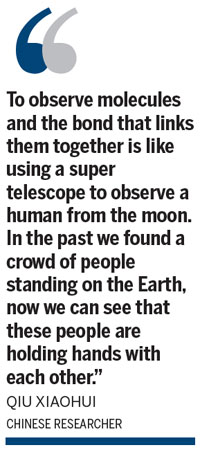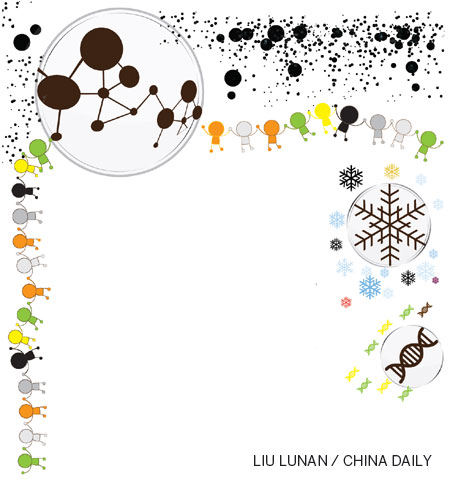Under the microscope
Updated: 2013-12-11 07:07
By Cheng Yingqi (China Daily)
|
|||||||||||
Advances in technology have allowed scientists to observe a hydrogen bond, a great leap forward in the study of life science. Cheng Yingqi reports.
Ever since Galileo Galilei invented the microscope 500 years ago, leaps in technology have extended our vision further into the world beyond the naked eye-from insects' eyes to cells, molecules and atoms. Now scientists are observing the hydrogen bond, a weak bond among individual molecules. "To observe molecules and the bond that links them together is like using a super telescope to observe a human from the moon. In the past we found a crowd of people standing on the Earth; now we can see that these people are holding hands with each other," says Qiu Xiaohui, an author of the research paper, Real-Space Identification of Intermolecular Bonding with Atomic Force Microscopy, which was recently published in Science magazine.
"The observation system opens up broad prospects for understanding the mechanism of intermolecular interactions."
"Chemical bonding, paralleled to periodic law of elements, is the greatest discovery in chemistry, which allows us to understand the chemical nature of matter," says Liu Minghua, director of the National Center for Nanoscience and Technology, China.
When two or more atoms join together to form a molecule, they are linked together by chemical bonding. The strongest type of chemical bond is a covalent bond.
"For an analogy, the covalent bonds are like your arms-they are stitched to a molecule. If we rip them off, the molecule falls apart, "Liu explains.
"The hydrogen bond, on the contrary, is like people holding each other's hands. The way they stand there holding their hands determines the shape of their formation-or the internal structure of a matter-but if we cut off the hydrogen bond, there will not be molecular changes, or what we call a chemical reaction," he says.
The first ever high-resolution images of covalent bonds were reported in 2009 by Leo Gross and his colleagues at IBM-Zu-rich Research Laboratory, yet the images of hydrogen bonds had never been captured before Qiu's team did so.
"It is already very difficult to capture an image of a covalent bond using the current microscopy techniques, not to say a hydrogen bond, which is much weaker than a covalent bond," Liu says.
Hydrogen bonds are decisive for the structure of some of the most essential substances in our life, like water, DNA and protein. "If scientists want to understand the reason why a snowflake has a delicate six-pointed shape, why DNA has a double-heli structure, and why protein folds into its optimum shape, we explain it by hydrogen bonds, though no one had ever seen it," Liu says.
"Now that we can see the image of hydrogen bonds directly, it will be a great help for future research of life science."
International debates over the nature of hydrogen bonds, however, did not cease until the recent publication of the real-space images published by the Chinese scientists, contributing this decisive evidence.
In 2011, the International Union of Pure and Applied Chemistry published a seven-page draft redefinition on hydrogen bonds after extensive research into evidence found over the past 40 years questioned the nature of this form of bond.
"Qiu Xiaohui and his team's real-space identification of hydrogen bonding has indeed been very, very important in my opinion, as I have seen chemists arguing endlessly about 'bonding' without solid experimental evidence," Elangannan Arunan says. Arunan is the chemistry professor of the Indian Institute of Science who led IUPAC's committee to redefine hydrogen bonds.
Flemming Besenbacher, founder and director of the Interdisciplinary Nanoscience Center located at Aarhus University, Denmark, says the work of Qiu's team "allows us to 'see' something invisible bonding".
"The intermolecular bonding is like an invisible glue linking molecules together to assemble molecules from DNA, protein to build up you and me," he says.
"Qiu used - in a very elegant way - the Atomic Force Microscope to image hydrogen bonds between DNA bases.

"For a life science, it is truly remarkable progress to see how DNA links, allowing us to investigate the origin of life. It is also possible to find mismatched and defective DNA, which may help and find a new way to cure disease," Besenbacher says.
Qiu and his team spent eight years refining the Atomic Force Microscope.
An Atomic Force Microscope is an extremely precise microscope that uses an atom-sized probe to move across the surface of a sample so that it is able to detect individual atoms and image them.
The precision of a general purpose Atomic Force Microscope reaches one-10th of a nanometer, but far from enough to see the hydrogen bond.
Qiu and his team redesigned the probe, and finally developed a new technologies package for probe production, which is patent pending.
The team also optimized mechanical design of the microscopy. And the precision of the specialized microscopy has reached sub-nanometer, or about a millionth of the width of a human hair.
"This is like how speed racers refit their vehicles - they modify the engine, the drive system, the shock attenuation device, etc.
"What I did is quite similar: I refit my Atomic Force Microscope. The probe is as important as my engine so I redesigned it, and I made changes to other parts to ensure they fit the high performance engine," he says.
The advancement of science equipment is without end, as is the exploration into hydrogen bonds.
"Maybe one day we will manage the technique to regulate hydrogen bonds, so that with those devices, we will be controlling the shape of DNA and protein as easy as pie," he says.
Contact the writer at chengyingqi@chinadaily.com.cn

(China Daily 12/11/2013 page22)
Today's Top News
US Congress negotiators reach budget deal
Conference maps nation's path for 2014
Chinese say their goodbyes to Mandela
China to intensify IPR protection
Chang'e-3 probe closer to the moon
Internet can 'help curb corruption'
Doors slam shut on laojiao
S Africa holds memorial service for Mandela
Hot Topics
Lunar probe , China growth forecasts, Emission rules get tougher, China seen through 'colored lens', International board,
Editor's Picks

|

|

|

|

|

|





